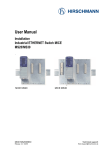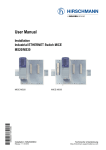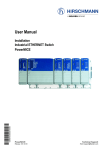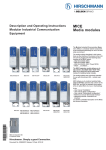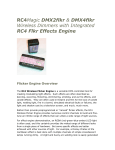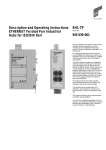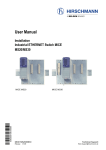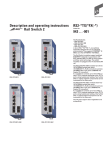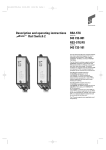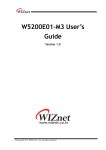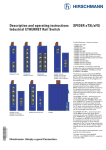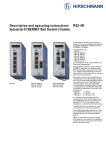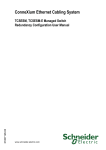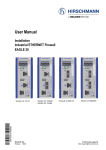Download Description and operating instructions iETHERNET Modular
Transcript
Anl_MICEus_02 23.11.2001 10:56 Uhr Seite 1 Description and operating instructions iETHERNET Modular Industrial Communication Equipment MICE Order No. 943 7..-001 The modular industrial communication equipment, MICE, is a modular network component. It was developed particularly for use in an industrial environment. The MICE described in this instructions consists of a switch and media modules that can be plugged into it. It allows you to construct switched ETHERNET networks that conform to the IEEE 802. and 802.3u standard using copper wires or optical fibers in a bus or ring topology. TP/TX/FL/FX terminal devices or other TP/TX/FL/FX segments can be connected to the 10/100 Mbit/s ports of the media modules. The TP/TX ports support autonegotiation and autopolarity. The switch, that can be managed using SNMP and the Web interface, supports both ETHERNET 10 MBit/s and Fast ETHERNET 100 MBit/s. The switches are mounted by simply snapping them onto a standard DIN rail. The MICEs have one V.24 interface for external management. In the„MICE Management Manual – i ETHERNET Modulare Industrial Equipment“ you find a detailled description of the MICE. F, the Hirschmann network management system, is the optimum management solution for this product. Your sales partner keeps information ready. Anl_MICEus_02 23.11.2001 10:56 Uhr Seite 2 We have checked that the contents of the technical publication agree with the hardware and software described. However, it is not possible to rule out deviations completely, so we are unable to guarantee complete agreement. However, the details in the technical publication are checked regularly. Any corrections which prove necessary are contained in subsequent editions. We are grateful for suggestions for improvement. We reserve the right to make technical modifications. Permission is not given for the circulation or reproduction of this document, its use or the passing on of its contents unless granted expressly. Contravention renders the perpetrator liable for compensation for damages. All rights reserved, in particular in the case of patent grant or registration of a utility or design. z Caution! means that light injury or damage to property can result if the appropriate safety measures are not taken. Note: is an important piece of information about the product, how to use the product, or the relevant section of the documentation to which particular attention is to be drawn. Certified usage Please observe the following: z Copyright © Hirschmann Electronics GmbH & Co. KG 2001 All Rights Reserved Warning The device may only be employed for the purposes described in the catalog and technical description, and only in conjunction with external devices and components recommended or approved by Hirschmann. The product can only be operated correctly and safely if it is transported, stored, installed and assembled properly and correctly. Furthermore, it must be operated and serviced carefully. Safety Guidelines Housing z Note: The lower covering panel of the MICE housing is grounded by the tophat rail and, as an option, by the separate ground screw. Make sure that the electrical installation meets local or nationally applicable safety regulations. z We would furthermore point out that for reasons of simplicity, these operating instructions cannot describe every conceivable problem associated with the use of this equipment. Should you require further information or should particular problems occur which are not treated in sufficient detail in the operating instructions, you can request the necessary information from your local Hirschmann sales partner or directly from the Hirschmann office (address: refer to chapter entitled „Notes on CE identification“). Safety Instructions This manual contains instructions which must be observed to ensure your own personal safety and to avoid damage to devices and machinery. The instructions are highlighted with a warning triangle and are shown as follows according to the degree of endangerment: z z 2 Danger! means that death, serious injury or considerable damage to property will result if the appropriate safety measures are not taken. Warning! means that death, serious injury or considerable damage to property can result if the appropriate safety measures are not taken. Warning! The ventilation slits must not be covered so as to ensure free air circulation. The distance to the ventilation slots of the housing has to be a minimum of 10 cm. Never insert pointed objects (thin screwdrivers, wires, etc.) into the inside of the subrack! This especially applies to the area behind the socket connectors. Failure to observe this point may result in injuries caused by electric shocks. Note We would point out that the content of these operating instructions is not part of, nor is it intended to amend an earlier or existing agreement, permit or legal relationship. All obligations on Hirschmann arise from the respective purchasing agreement which also contains the full warranty conditions which have sole applicability. These contractual warranty conditions are neither extended nor restricted by comments in these operating instructions. Warning! Only technicians authorized by Hirschmann are permitted to open the housing. Safety Guidelines Power Supply Note: According to EN 60950 the device may only be operated in a fire protective housing. Switch the basic devices on only when the case is closed. Note: The housing has to be mounted in upright position. z Warning! The devices may only be connected to the supply voltage shown on the type plate. The devices are designed for operation with a safety extra-low voltage.Thus, they may only be connected to the supply voltage connections and to the signal contact with the safety extra-low voltages (SELV) in compliance with IEC950/ EN60950/ VDE0805. For the case where the module is operated with external power supply: Use only a safety extra-low voltage in accordance with IEC 950/EN 60 950/VDE 0805 to power the system. First of all you connect the protecting line, before you establish the further connections. When you remove connections, you disconnect the protecting line last. Safety Guidelines Shielding Ground Note: The shielding ground of the connectable twisted pairs lines is connected to the front panel as a conductor. Beware of possible short circuits when connecting a cable section with conductive shielding braiding. Safety Guidelines Environment z Warning! The device may only be operated in the listed ambient temperature range at the listed relative air humidity (non-condensing). The installation location is to be selected so as to ensure compliance with the climatic limits listed in the Technical Data. Staff qualification requirements Note: Qualified personnel, as understood in this manual and in the warning signs, are persons who are familiar with the setup, assembly, startup, and operation of this product and are appropriately qualified for their job. This includes, for example, those persons who have been: – trained or directed or authorized to switch on and off, to ground and to label power circuits and devices or systems in accordance with current safety engineering standards – trained or directed in the care and use of appropriate safety equipment in accordance with the current standards of safety engineering – trained in providing first aid. Anl_MICEus_02 23.11.2001 10:56 Uhr Seite 3 General Safety Instructions The product can be used in the residential sphere (residential sphere, business and trade sphere and small companies) and in the industrial sphere. – Interference immunity: EN 61000-6-2:1999 – Radio interference level: EN 55022:1998 Class A This device is electrically operated. Adhere strictly to the safety requirements relating to voltages applied to the device as described in the operating instructions! z Warning! Failure to observe the information given in the warnings could result in serious injury and/or major damage. Only personnel that have received appropriate training should operate this device or work in its immediate vicinity. The personnel must be fully familiar with all of the warnings and maintenance measures in these operating instructions. Correct transport, storage, and assembly as well as careful operation and maintenance are essential in ensuring safe and reliable operation of this device. These products are only to be used in the manner indicated in this version of the ”Description and Operating Instructions”. Particular attention is to be paid to all warnings and items of information relating to safety. z Warning! This is a Class A device. This equipment may cause radio interference if used in a residential area; in this case it is the operator´s responsibility to take appropriate measures. The precondition for compliance with EMC limit values is strict adherence to the construction guidelines specified in this description and operating instructions. , Recycling Note: After its use, this product has to be processed as electronic scrap and disposed of according to the prevailing waste disposal regulations of your community / district / country / state. FCC Note: This equipment has been tested and found to comply with the limits for a Class A digital device, persuant to part 15 of the FCC Rules. These limits are designed to provide reasonable protection against harmful inter- Warning! Any work that may have to be performed on the electrical installation should be performed by fully qualified technicians only. Based specifications and standards: The devices fulfil the following specifications and standards: – EN 61000-6-2:1999 Generic standards – Immunity for industrial environments – EN 55022:1998 – Information technology equipment – Radio disturbance characteristics – EN 60950:1997 – Safety of Information Technology Equipment (ITE) – EN 61131-2:1994 – Programmable Controllers – CFR-47 Part 15:1997 – Code of Federal Regulations 7 z ference when the equipment is operated in a commercial environment. This equipment generates, uses, and can radiate radio frequency energy and, if not installed and used in accordance with the instruction manual, may cause harmful interference to radio communications. Operation of this equipment in a residential area is likely to cause harmful interference in which case the user will be required to correct the interference at his own expense. Notes on CE identification The devices comply with the regulations of the following European directive: Device status LEDs Media modules Display status LEDs Display selection key LEDs port status Pluggable terminal block 6pole V.24 access external management 3pole DIP switch 2-4 ports per media module Fig. 1: Overview interfaces, display elements and controls of the MICE 89/336/EEC Council Directive on the harmonization of the legal regulations of member states on electromagnetic compatibility (amended by Directives 91/263/EEC, 92/31/EEC and 93/68/EEC). The EU declaration of conformity is kept available for the responsible authorities in accordance with the above-mentioned EU directives at: Hirschmann Electronics GmbH & Co. KG Automation and Network Solutions Stuttgarter Straße 45-51 D-72654 Neckartenzlingen Telephone ++49-7127-14-1538 3 Anl_MICEus_02 23.11.2001 10:56 Uhr Seite 4 1. Functional description The ports of a MICE represent a terminal connection for the connected LAN segment. You can connect single devices or complete network segments. 1.1 FRAME SWITCHING FUNCTIONS Store and Forward All data received by the MICE from the system bus or at the ports are stored and checked for validity. Invalid and defective frames (> 1.522 byte or CRC error) as well as fragments (< 64 byte) are discarded. The MICE forwards the valid frames. Multi address capability A MICE learns all source addresses per port. Only packets with – unknown addresses – addresses learnt at this port – a multi/broadcast address in the destination address field are sent to this port. A MICE learns up to 4,000 addresses. This becomes necessary if more than one terminal device is connected to one or more ports. In this way several independent subnetworks can be connected to a MICE. Learnt addresses A MICE monitors the age of the learned addresses. The MICE deletes address entries from the address table which exceed a certain age (30 seconds). Note: Restarting deletes the learned address entries. Priority The MICE supports two priority queues (traffic classes complying with IEEE802.1D). The classification of received data packets to these classes is done by the priority of the data packet included in the VLAN tag. Tagging (IEEE 802.1Q) The IEEE 802.1 Q standard designates the VLAN tag to be included in a MAC data frame for the VLAN and prioritizing functions. The VLAN tag consists of 4 bytes. It is inserted between the source address field and the type field. For data packets with VLAN tag the MICE analyses the 3 bit priority field of the VLAN tag. The MAC data frame is transmitted unchanged by the MICE. 1.2 SPECIFIC FUNCTIONS OF THE TP/TX INTERFACE Link control The MICE monitors the connected TP/TX line segments for short-circuit or interrupt using regular link test pulses in accordance with IEEE standard 802.3 10/100BASETP/TX. The MICE does not transmit any data to a TP/TX segment from which it does not receive a link test pulse. Note: A non-occupied interface is assessed as a line interrupt. The TP/TX line to terminal equipment which is switched off is likewise assessed as a line interrupt as the deenergised bus coupler cannot transmit link test pulses. Auto polarity exchange If the receive line pair is incorrectly connected (RD+ and RD- switched) polarity is automatically reversed. 4 Automatic detection of line pairs If the autonegotiation function is active, the MICE detects the transmit and receive pairs (MDI, MDI-X). The MICE automatically configures its port for the correct transmit and receive pins. Consequently it does not matter whether you connect devices using a cross-over or straight cable. 1.3 SPECIFIC FUNCTIONS OF THE F/O INTERFACE Link control According to IEEE 802.3 standard 100BASEFX a MICE monitors the attached F/O lines for open circuit conditions. 1.4 REDUNDANCY FUNCTIONS Backbone as a ring (HIPER-Ring) With the RM function (redundancy manager) of the MICE you can close a line structured RS1, RS2-…/…, MICE or MACH 3000 backbone to a redundant ring. If one section fails the ring structure changes itself back into a line structure within 0.5 seconds in a ring with up to 50 switches. 1.5 SECURITY Port security A MICE protects every port from unauthorized access. The following functions are available for the security monitoring of every single port: – Who has access to this port? – Actions which result on an unauthorized access – How to proceed in case of an access of an unknown user 1.6 FURTHER FUNCTIONS AND FEATURES Diagnosis In case of a reset the MICE runs a hardware self test. During operation an integrated watch dog (monitoring unit) monitors the function of the software. Reset The MICE will be reset by the following actions: – management – input voltages fall below a threshold – watchdog – faulty internal clock. After a reset the following actions are carried through: – self test – initialization 1.7 DISPLAY ELEMENTS After applying the operating voltage, the software starts and initializes itself. The MICE then performs a selftest. Various LEDs light up in the process. The process lasts approximately 30 seconds. Device status These LEDs provide information about statuses which affect the function of the entire MICE. P – Power (green LED) – lit: – internal supply voltage present – not lit: – internal supply voltage is too low P1 – Power 1 (green LED) – lit: – supply voltage 1 present – not lit: – supply voltage 1 is less than 18 V P2 – Power 2 (green LED) – lit: – supply voltage 2 present – not lit: – supply voltage 2 is less than 18 V FAULT – Failure (red LED) – lit: – The indicator contact is open, i.e. it indicates an error. – not lit: – The indicator contact is closed, i.e. it does not indicate an error. RM – Redundancy Manager (green/yellow LED) – lit green: – RM function active, redundant port not active – lit yellow: – RM function active, redundant port active – not lit: – RM function not active Display status Each media module has one LED per port. The meaning of these port status LEDs depends on the setting on the switch basic module. The display meaning can be set with the „SELECT“ button on the switch basic module. Press the button approximately 2 seconds to continue switching the meaning of the display. If the button is not pressed for approximately 20 seconds, the display status changes to "L/D.“ L/D – data, link status (green LED) – lit green: – The port LEDs of the media modules display the connection status. FDX – fullduplex (green LED) – lit green: – The port LEDs of the media modules display the connection type, full or half duplex. 100 – 10/100 Mbit/s (green LED) – lit green: – The port LEDs of the media modules indicate the transmission rate. AUTONEG – autonegotiation (green LED) – lit green: – The port LEDs of the media modules indicate the port configuration type. RING PORT – HIPER-Ring port (green LED) – lit green: – The port LEDs of the media modules indicate the HIPER-Ring assignment. LED TEST – LED test (green LED) – lit green: – The status, display status and port status LED test is active. The status LED "RM“ blinks green/yellow. The status LED "FAULT“ blinks red. The display status LEDs blink green. The port status LEDs of the media modules blink green/yellow. Anl_MICEus_02 23.11.2001 10:56 Uhr Seite 5 Port Status These LEDs display port-related information. Set the contents of the information with the button on the switch basic module. 1 to 4 – Data, Link status (green/yellow LED) – not lit: – no valid link – lit green: – valid link – blinking green (1 single blink per period) – port is switched to standby (port 1) – blinking green (3 blinks per period) – port is disabled – flashes yellow:– receiving data 1 to 4 – FDX (green/yellow LED) – lit green: – full duplex is active. – not lit: – half duplex is active. 1 to 4 – 100 (green/yellow LED) – lit green: – 100 Mbit/s is active. – not lit: – 10 Mbit/s ist active. 1 to 4 – AUTONEG (green/yellow LED) – lit green: – autonegotiation is active. – not lit: – autonegotiation is not active. 1 to 4 – RING PORT (green/yellow LED) – lit green: – this port is part of the HIPER-Ring. – not lit: – this port is not part of the HIPER-Ring. 1 to 4 – LED TEST (green/yellow LED) – blinks green/yellow:– LED Test is active. – not lit: – LED defective. 1.8 CONTROLS 3-pin DIP switch (MICE) With the 3-pin DIP switch in the covering panel of the switch basic module – you can switch on or off the RM functionality (Redundancy Manager) with the RM switch. State of delivery: switch in position 0 (Off), i.e. RM function not active. – You can select the port with the ring port switch for the HIPER-Ring. In the delivery state (OFF position), ports 1 and 2 form the connection for the HIPERRing. In the ON position, ports 1 and 5 form the connection for the HIPER-Ring. In the ON position, there is also a redundancy of the media module. The ON position offers the option of changing media within the HIPER-Ring. Position: OFF – Ring Port 1 & 2 – ON Redundancy Manager (RM) Ring Port 1 & 5 – – Pin configuration of the RJ45 socket: – TD+: pin 3, TD-: pin 6 – RD+: pin 1, RD-: pin 2 – remaining pins: not used. n.c. n.c. TDn.c. n.c. TD+ RDRD+ Fig. 3: Pin configuration of a TP/TX interface 10 Mbit/s F/O connection 10 MBit/s F/O ports (ST sockets) make it possible to connect terminal devices or independent network segments compliant with the IEEE 802.3 10BASE-FL standard. These ports support full and half duplex operation. State of delivery: half duplex. Note: 10 Mbit/s ports are not ring ports. 100 Mbit/s F/O connection 100 MBit/s F/O ports (MTRJ or DSC sockets) make it possible to connect terminal devices or independent network segments compliant with the IEEE 802.3 100BASE-FX standard. These ports support full and half duplex operation. State of delivery: full duplex. V.24 interface (external management) A serial interface for local connection of an external management station (VT100 terminal or a PC with corresponding terminal emulation) is available via the RJ11 socket (V.24 interface). A link can thus be established with the User Interface UI. VT100 terminal settings: – Speed: 9,600 Baud – Data: 8 bit – Stopbit: 1 bit – Handshake: off – Parity: none The socket casing is galvanically connected to the lower panel of the device. The signal lines are galvanically separated from the operating voltage (60 V isolation voltage) and the lower panel. – Pin configuration of the V.24 interface: – TX: Pin 3, RX: Pin 5 – CTS: Pin 1, RTS: Pin 6 – GND: Pin 4 – Pin 2: not used. Factory settings: autonegotiation active (except for the HIPER ring port). The socket housings are electrically connected to the lower panel of the module. The pin configuration complies with MDI-X. Pin 6 Pin 5 Pin 4 Pin 3 Pin 2 Pin 1 Warning! The MICE equipment is designed for operation with SELV. Only safety extra-low voltages to IEC950/EN60950/VDE0805 may therefore be connected to the supply voltage connections and to the indicator contact. – Voltage supply: Redundant voltage supplies are supported. Both inputs are decoupled. There is no load distribution. With redundant supply, the power pack supplies the MICE only with the higher output voltage. The supply voltage is electrically isolated from the housing. – Indicator contact: The indicator contact is used to supervise the functions of the MICE and thus facilitates remote diagnosis. Contact interrupt indicates the following by means of a potential-free indicator contact (relay contact, closed circuit): – the failure of at least one of the two supply voltages. – a permanent fault in the MICE (internal 3,3 V DC voltage, supply voltage 1 or 2 < 18 V, ...). – the faulty link status of at least one port. The indication of the link state on the MICE can be masked on a port-by-port basis using the management software. State of delivery: there is no link test. – self test error In addition the MICE in RM mode can indicate the following states: – Ring monitoring is not possible, e. g. during software initializing. Note: In the case of the voltage supply being routed without redundancy, the MICE indicates the failure of a supply voltage. You can prevent this message by feeding in the supply voltage through both inputs. +24 V (P1) The V.24 interface baud rate can be configured to 9,600 or 19,200 baud. The factory default is 9,600 baud. Fig. 2: 3-pin DIP switch 1.9 INTERFACES 10/100 MBit/s connection 10/100 Mbit ports (8-pin R45 sockets) allow terminal equipment or independent network segments complying with the standards IEEE 802.3 100BASE-TX / 10BASE-T to be connected. These ports support autonegotiation and the autopolarity function. Pin 8 Pin 7 Pin 6 Pin 5 Pin 4 Pin 3 Pin 2 Pin 1 z Pin number V.24 interface Pin 1 Pin 2 Pin 3 Pin 4 Pin 5 Pin 6 CTS not connected TX GND RX RTS CTS RTS RX TX Clear To Send Request To Send Receive Data Transmit Data Fault +24 V (P2) Fig. 9: Pin configuration of 6pin terminal block Ground connection The lower covering panel of the MICE housing is grounded by the tophat rail and, as an option, by the separate ground screw. 2. Configuration 2.1 LINE STRUCTURE The MICE enables backbones in line structures to be built up. Cascading takes place via the ring ports. Fig. 5: Pin configuration of the V.24 interface Note: In chapter 6 „Technical data“ you find the order number for the terminal access cable which is to be ordered separately. 2.2 REDUNDANT RING STRUCTURE With the RM function (redundancy manager) of the MICE or with an MACH 3000 can close the two ends of a line structured backbone to form a redundant ring. 6-pin terminal block The supply voltage and the indicator contact are connected via a 6pin terminal block with screw locking mechanism. 5 Anl_MICEus_02 23.11.2001 10:56 Uhr Seite 6 The MICE is integrated into the ring via the ring ports (ports 1&2 or 1&5). Within a redundant ring any mixture of MICE, MACH 3000, RS1 and RS2-…/… is possible. If one section fails the recovery time is less than 0.5 seconds for a ring containing up to 50 MICE/MACH 3000/RS1/RS2-…/… being cascaded and the ring structure is changed back into a line structure. Note: The „HIPER-Ring“ function requires the following settings for the ring ports: 100 Mbit/s, full duplex and autonegotiation off (= state of delivery). Note: Activate the RM function of a MICE or a MACH 3000. 3. Assembly, startup procedure and dismantling 3.1 UNPACKING, CHECKING Check whether the package was delivered complete (see scope of delivery). Check the individual parts for transport damage. Notes: The lower covering panel of the housing is grounded by the tophat rail and, as an option, by using the ground screw. Warning! Use only undamaged parts! z – Do not open the housing. 3.2 ASSEMBLY The equipment is delivered in a ready-tooperate condition. Media modules can be assembled and disassembled during running operation. The following procedure is appropriate for assembly: – The shielding ground of the twisted pair lines which can be connected is electrically connected to the front panel. To fasten a media module, first remove the protective cap over the plug. Plug the media module onto the plug. Tighten the 4 screws on the corners of the media module. Check whether the switch pre-setting suits your requirements (see chap. 1.8). Pull the terminal block off the MICE and wire up the supply voltage and indicator lines. Fit the MICE on a 35 mm standard bar to DIN EN 50 022. Attach the upper snap-on slide bar of the MICE to the standard bar and press it down until it locks in position. Fit the signal lines. Fig. 8: Assembling the MICE RS2 MICE RS1 MICE 3.3 STARTUP PROCEDURE You start up the MICE by connecting the supply voltage via the 6-pin terminal block. Lock the terminal block with the locking screw at the side. RS2 MICE line structure Abb. 6: Linienstruktur RS2: RS2-TX/TX, RS2-FX/FX or RS2-FX-SM/FX-SM RS2 RS1 RS2 RS1 RS2 MICE redundant ring ring closed by MICE with switch RM on position "ON" MICE RS2 MICE Abb. 7: Redundante Ringstruktur 6 RS2 MICE MICE RS2 Anl_MICEus_02 23.11.2001 10:56 Uhr Seite 7 3.4 BASIC SETTINGS On the first installation of the MICE you have to enter the IP addresse(s). The MICE provides 3 possibilities to configure the IP addresses (refer to MICE manual): – Configuration via BOOTP (bootstrap protocol) – Configuration via DHCP (dynamic host configuration protocol) – Input via the V.24 interface. 3.5 DISMANTLING In order to remove the MICE from the tophat rail, press the MICE downward and pull it out from under the tophat rail. 4. Management 4.1 INTODUCTION The MICE supports SNMP and Web-based management and thus offers a extensive diagnosis and configuration functions for an easy startup procedure as well as extensive network- and device information. The MICE supports the TCP/IP protocol family. You will find detailed descriptions regarding the SNMP management, functionality of the User Interface, web interface, system monitors, software update and Management Information Base MIB in the MICE manual. 4.2 SNMP MANAGEMENT – Factory settings: All parameters which can be adjusted via management are pre-set to default values. You will find detailed descriptions in the MICE manual. 4.3 USER INTERFACE The User Interface (UI) can be used in addition to the web interface. On the first installation of the MICE you have to enter IP addresse(s). If you do not have a VT100 terminal near the installation place at your disposal, you can enter the IP addresses before the final installation. For that you need a VT100 terminal or a corresponding emulation (e.g. MS windows terminal). The User Interface starts after pressing any key. – State of delivery: password „private“ – System parameters Among others various addresses can be entered in the window presented on the screen (IP address, netmask, gateway IP address) and the IP configuration mode can be selected. 4.4 WEB-BASED INTERFACE In order to open the Web-based interface you need a Web browser (program which enables to read hypertext), for example the Netscape Navigator/Communicator or the Microsoft Internet Explorer from version 4.x on. Note: The Web-based interface uses the plugin "Java runtime environment version 1.2". If this is not installed on your computer, an installation via the internet is started automatically on the first start of the Webbased interface. This installation takes a lot of time. For Windows NT users: Because of that stop the installation. Install the plugin from the enclosed CDROM. For that start the program file j2re1_3_0-win-i.exe in the Java table on the CDROM. Access to the web interface is protected by a password. If you do not enter a password, only read access to the MICE is possible. – Factory setting: password „private“ 5. Further support In the event of technical queries, please talk to the Hirschmann contract partner responsible for looking after your account or directly to the Hirschmann office. You can find the addresses of our contract partners – on the Internet (http://www.hirschmann.de). Our support line is also at your disposal: Tel. +49(7127) 14-1538 (Fax -1542) Answers to Frequently Asked Questions can be found on the Hirschmann internet site www.hirschmann.de The FAQs are located under „Service“ in the Automation and Network Solutions section. 6. Technical data General data Operating voltage Buffer time 24 VDC, -25% +33% safety extra-low voltage (SELV) (redundant inputs decoupled) min. 10 ms at 24 VDC Potential difference between input voltage and housing Potential difference to input voltage, +24 VDC: 32 VDC Potential difference to input voltage, ground: -32 VDC Current consumption with media modules Overload current protection at input Dimensions W x H x D Weight Ambient temperature Storage temperature Humidity Atmospheric pressure Laser protection Protection type Radio disturbance characteristics Immunity 0,9 A maximum, at 24 VDC non-changeable fuse 120 mm x 134 mm x 99 mm 4.7 in x 5.3 in x 3.9 in 1 kg 2.2 lb 0 ºC to + 55 ºC, 32 °F to 131 °F (with MM2 - 4FXM3: 0 ºC to + 50 ºC, 32 °F to 122 °F) - 20 ºC to + 80 ºC -4 °F to 176 °F 10% to 95% (non condensing) 795 hPa minimum Class 1 conforming to EN 60825 IP 20 EN 55022 Class A, CFR-47 Part 15 Class A Electrostatic discharge EN 61000-4-2 level 3 Electromagnetic fields EN 61000-4-3 level 3 Bursts EN 61000-4-4 level 3 Surge EN 61000-4-5 Conducted disturbance EN 61000-4-6 level 3 Mechanical service conditions Vibrations Shocks IEC 60068-2-6 Test Fc IEC 60068-2-27 Test Ea Network size TP port 100BASE-T/TX Length of a twisted pair segment F/O port 10BASE-FL System attenuation 50/125 µm fiber (multimode) 62,5/125 µm fiber (multimode) Wave length 100 m (328 ft) typ. 11 dB 14 dB 850 nm 7 Anl_MICEus_02 23.11.2001 10:57 Uhr Seite 8 F/O line length 10 BASE-FL (example) 50/125 µm fiber (multimode) 62,5/125 µm fiber (multimode) 2,6000 m (8,530 ft) maximum 3,600 m (11,811 ft) maximum F/O port 100BASE-FX System attenuation 50/125 µm fiber (multimode) 62,5/125 µm fiber (multimode) 10/125 µm fiber (singlemode) Wave length 8 dB 11 dB 16 dB 1300 nm F/O line length (example) 50/125 µm fiber (multimode) 62,5/125 µm fiber (multimode) 10/125 µm fiber (singlemode) 5 km (16,400 ft) maximum 4 km (13,120 ft) maximum 30 km (98,420 ft) maximum Interfaces MS2108 - 2 MM2 - 2FLM4 MM2 - 4TX1 MM2 - 4FXM3 MM2 - 2FXM3 / 2TX1 MM2 - 2FXM2 MM2 - 2FXS2 (data of fiber: 3 dB/km, 400 MHz*km) (data of fiber: 3.2 dB/km, 200 MHz*km) (data of fiber: 1 dB/km, 800 MHz*km) (data of fiber: 1 dB/km, 500 MHz*km) (data of fiber: 0,4 dB/km) V.24 port Signaling relay Power supply 2 FL-Ports 4 TP/TX-Ports 2 FX-Ports 2 FX-Ports 2 TX-Ports 2 FX-Ports 2 FX-Ports external management 1 A, 24 V maximum 1 x green LED 1 x green LED 1 x green LED 1 x red LED 1 x green/yellow LED 1 x green LED 1 x green LED 1 x green LED 1 x green LED 1 x green LED 1 x green LED 2 x green LED 4 x green/yellow LED P – Power, internal supply voltage present P1 – Power 1, internal supply voltage 1 present P2 – Power 2, internal supply voltage 2 present FAULT – Failure, the indicator contact is open and indicates an error RM – Redundancy Manager L/D – Data/Link status FDX – Full duplex 100 – 10/100 Mbit/s AUTONEG – Autonegotiation RING PORT – HIPER-Ring port LED TEST – LED test for service use 1 to 4 – The meaning depends on the setting of the display status. (ST sockets, multimode, 10 MBit/s) (RJ45 sockets,10/100 MBit/s) (MTRJ sockets, multimode, 100 MBit/s) (MTRJ sockets, multimode, 100 MBit/s) and (RJ45 sockets, 10/100 MBit/s) (DSC sockets, multimode, 100 MBit/s) (DSC sockets, singlemode, 100 MBit/s) Displays Device status Display status Port status Controls 3-pole DIP switch RM – activate redundancy manager functionality Ring Port – defining HIPER-Ring ports Scope of delivery MICE MS2108 - 2 incl. Terminal block for power supply and indicator contact Labels, description and operating instructions MICE manual on CD-ROM Order number MS2108 - 2 MM2 - 2FLM4 MM2 - 4TX1 MM2 - 4FXM3 MM2 - 2FXM3 / 2TX1 MM2 - 2FXM2 MM2 - 2FXS2 943 717-001 943 734-001 943 722-001 943 721-001 943 720-001 943 718-001 943 719-001 Accessories Basics manual Terminal access cable Rail Power Supply RPS 60 Rail Power Supply RPS 120 Network Management Software HiVision 039 624-001 943 301-001 943 662-001 943 662-011 943 471-100 Hirschmann Electronics GmbH & Co. KG Automation and Network Solutions Stuttgarter Straße 45-51 D-72654 Neckartenzlingen Germany Tel.: ++49 / 7127 / 14-1538 Fax: ++49 / 7127 / 14-1542 E-Mail: [email protected] Internet: http://www.hirschmann.com Printed in Germany Subject to alterations 039649001021101000








